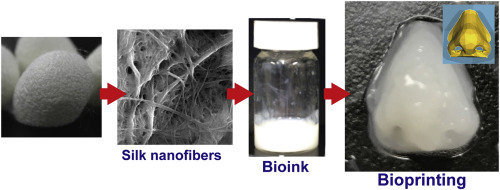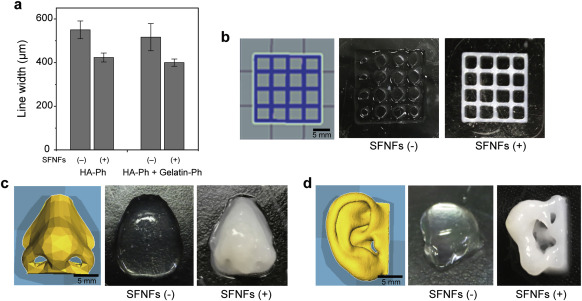Researchers from the Japanese Osaka University have developed a new silk fiber-based bio-ink for fabricating cell-laden structures with improved printability.
By removing the sericin protein from virgin silk and grinding it into nanofibers, the scientists were able to integrate the material into a series of cell and polymer-infused bio-inks. The fibers were found to actively minimize the internal stresses placed on cells during 3D printing, which improved their survivability and allowed them to retain complex shapes.
Leveraging their novel bioprinting material, the team 3D printed a range of cell-based objects including a nose-shaped structure, while keeping more than 85 percent of its component cells alive. Given that their bio-ink is based on human-compatible silk, the researchers believe that in the future, it could be utilized within real-world biomedical applications.
“Our silk fibers are excellent additives to bioink cell printing media,” said the study’s lead author Shinji Sakai. “They are compatible with many media, such as those containing gelatin, chitosan, or hyaluronic acid, giving them a broad range of potential applications.”

Advancing 3D printable bio-inks
In recent years, 3D bioprinting has attracted a great deal of attention as a means of fabricating cell-laden structures that mimic functional organs and tissues. While these new approaches have shown vast therapeutic potential and yielded various miniature 3D printed body parts, the technology remains years away from end-use application.
Scientists from the University of Texas at El Paso (UTEP) for instance, 3D printed mini-hearts in January 2020 and sent them to the International Space Station for testing. Elsewhere, a team at the University of Minnesota have bioprinted a miniature beating human heart, while United Therapeutics has refurbished a factory as it intends to 3D print kidneys on a larger scale.
Many of these mini-organs are created by extruding a cell-laden bio-ink, in a layer-by-layer approach via a micronozzle attached to a 3D printer. Using an extrusion-based method allows for the creation of complex structures, with materials that can be customized to control cell proliferation and differentiation, but they also have drawbacks.
The problem with extruding bio-inks is that their printability is often improved by increasing their viscosity, but this causes shear stress during printing, which in turn, damages the ink’s cells. In order to combat this, some researchers have used nanomaterials such as cellulose nanofibers as supporting additives, which have been proven to make bio-inks more resilient to printing.
At present though, many additive-supported bio-inks need to be customized for each application, which makes them difficult to roll-out on a wider basis. As an alternative, the Osaka team hypothesized that Silk Fibroin Nanofibers (SFNFs) could be used as an additive, to produce a bio-ink that enhances cell viability, without limiting its compatibility.

The Osaka team’s silk-based biomaterial
Within modern medicine, silk is often used in sutures, surgical meshes, and fabrics, and clinical trials are currently underway to assess its wound-healing capabilities. To access these medicinal qualities though, removing sericin from silk via a ‘degumming’ process is vital before medical use, as the chemical is proven to be inflammatory to human tissue.
Consequently, the Osaka team began their experiments by obtaining degummed silk measuring 100–300 nm in diameter and grinding it into water, yielding dispersed fibroin fibers. The silk extracts were subsequently sterilized, and mixed with a 10 percent volume fetal bovine serum, gelatin, and a mixture of aqueous polymers.
Once the team’s concoction had been humidified in a CO2 incubator, it was cross-linked using horseradish peroxidase (HRP)–catalyzed reaction, to provide it with enhanced strength during printing. Leveraging an extrusion-based system, the team summarily 3D printed their novel SFNF material into several lines of cells.
Not only did the research team’s new bio-inks prove to print more consistently than regular cells, but they were capable of producing more complex objects too. The team went on to successfully fabricate nose and ear-shaped structures, ultimately proving the effectiveness of SFNFs as an additive for improving printability.
The researchers also tested the cell viability of their bio-ink by producing a range of fibroblast 10T1/2 cell-laden constructs, including a mixture of SFNF-reinforced gels, and non-supported structures. After one hour, the objects showed the same level of survivability at 92.5 percent and 92.7 percent respectively, and after nine days, the SFNF structures boasted cell viability of more than 85 percent.
As a result, the team concluded that their bio-ink additive had no adverse effect on the survival rate of cells in bioprinted structures while demonstrating robust mechanical performance, and ease of processing. In the future, the researchers believe that their novel SFNFs could be used as an alternative to cellulose fibers, as a means of enhancing the shear-thinning behavior of bio-inks.
The team’s findings are detailed in their paper titled “Silk fibroin nanofibers: a promising ink additive for extrusion three-dimensional bioprinting.” The research was co-authored by S.Sakai, A.Yoshii, S.Sakurai, K.Horii, and O.Nagasuna, and published in the Materials Today Bio journal.
To stay up to date with the latest 3D printing news, don’t forget to subscribe to the 3D Printing Industry newsletter or follow us on Twitter, or liking our page on Facebook.
Are you looking for a job in the additive manufacturing industry? Visit 3D Printing Jobs for a selection of roles in the industry.
Featured image shows a silkworm emerging from its cocoon. Photo via Pixabay.



